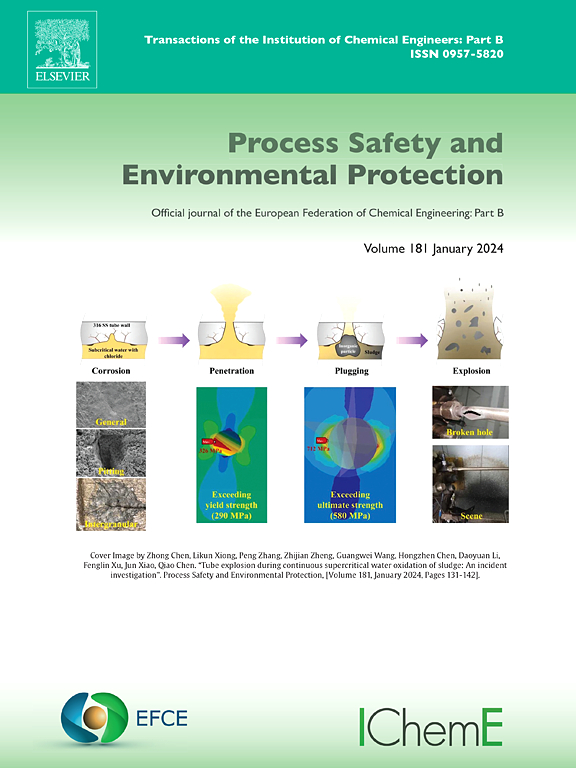井下轴流旋流分离管柱结构优化
IF 6.9
2区 环境科学与生态学
Q1 ENGINEERING, CHEMICAL
引用次数: 0
摘要
单井注采技术是高含水油田经济开发的有效解决方案,井下油水分离是保证其高效运行的关键。为了满足陆上油田5.5英寸套管尺寸要求,提高单井注采工艺的分离性能,创新性地提出了双泵吸式单井注采工艺(DPS-SWIPT),设计了轴流式旋流分离管柱(AFCSPS)。基于Plackett-Burman (PB)设计方法,计算了结构参数对AFCSPS分离性能的影响程度。采用响应面法(RSM)和人工智能(AI)算法对旋风分离器管柱结构参数进行优化。建立了多变量响应数学模型,定量描述了结构参数与分离效率之间的关系。结果表明,麻雀搜索算法反向传播神经网络-遗传算法(SSABP-GA)优化算法效果最佳,分离效率达到99.93 %。水力旋流器在各种运行参数和物理参数下的分离效率均保持在95.38 %以上,说明优化结构在研究范围内具有较高的适应性。数值模拟结果与实验结果吻合良好,分离效率的平均误差在1.48 %以内。该研究可为该设备在井下油水分离技术中的应用提供支持和参考。本文章由计算机程序翻译,如有差异,请以英文原文为准。
Structural optimization of downhole axial-flow cyclone separation pipe string
Single-well injection-production technology (SWIPT) is an effective solution for the economic development of high-water-cut oilfields, with downhole oil-water separation playing a crucial role in ensuring its efficient operation. In order to meet the 5.5-inch casing size requirements of onshore oilfields and enhance the separation performance of single-well injection-production technology, a dual-pump suction single-well injection-production technology (DPS-SWIPT) was innovatively proposed, and an axial-flow cyclone separation pipe string (AFCSPS) was designed. The significance of structural parameters affecting the AFCSPS separation performance is calculated based on the Plackett-Burman (PB) design method. Response surface methodology (RSM) and artificial intelligence (AI) algorithms were employed to optimize the structural parameters of the cyclone separation pipe strings. A multivariate response mathematical model has been developed to quantitatively describe the relationship between structural parameters and separation efficiency. A comparison of the optimization methods reveals that the sparrow search algorithm back propagation neural networks-genetic algorithm (SSABP-GA) optimization algorithm yields the best results, with the value of separation efficiency reaching 99.93 %. The separation efficiency of the hydrocyclone remained above 95.38 % across various operating and physical parameters, indicating that the optimal structure demonstrates a high degree of adaptability within the studied range. Numerical simulations and experimental results show good agreement for oil core morphology and separation efficiency, within an average efficiency error of 1.48 %. The study can provide support and reference for the application of the equipment in downhole oil-water separation technology.
求助全文
通过发布文献求助,成功后即可免费获取论文全文。
去求助
来源期刊

Process Safety and Environmental Protection
环境科学-工程:化工
CiteScore
11.40
自引率
15.40%
发文量
929
审稿时长
8.0 months
期刊介绍:
The Process Safety and Environmental Protection (PSEP) journal is a leading international publication that focuses on the publication of high-quality, original research papers in the field of engineering, specifically those related to the safety of industrial processes and environmental protection. The journal encourages submissions that present new developments in safety and environmental aspects, particularly those that show how research findings can be applied in process engineering design and practice.
PSEP is particularly interested in research that brings fresh perspectives to established engineering principles, identifies unsolved problems, or suggests directions for future research. The journal also values contributions that push the boundaries of traditional engineering and welcomes multidisciplinary papers.
PSEP's articles are abstracted and indexed by a range of databases and services, which helps to ensure that the journal's research is accessible and recognized in the academic and professional communities. These databases include ANTE, Chemical Abstracts, Chemical Hazards in Industry, Current Contents, Elsevier Engineering Information database, Pascal Francis, Web of Science, Scopus, Engineering Information Database EnCompass LIT (Elsevier), and INSPEC. This wide coverage facilitates the dissemination of the journal's content to a global audience interested in process safety and environmental engineering.
 求助内容:
求助内容: 应助结果提醒方式:
应助结果提醒方式:


